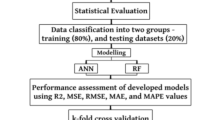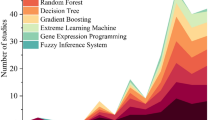Abstract
High-performance concrete (HPC) is a crucial material for constructing critical structures, such as dams, bridges, and high-rise buildings, as its exceptional compressive strength (CS) is vital for ensuring structural integrity. To improve this strength, additives, such as fly ash (FA) and micro-silica (MS), can be added to the mixture, often by reducing the water-to-cement ratio, alongside other factors. However, accurate modeling is imperative to estimate the CS of HPC. In this paper, support vector regression (SVR) is a newly developed regression model demonstrating superior performance in HPC compressive strength. Furthermore, two novel optimization algorithms, the African Vulture Optimization Algorithm (AVOA), and Salp Swarm Algorithm (SSA), are utilized to improve the performance of the SVR model. Each SVR-AVOA and SVR-SSA hybrid model was evaluated by 168 experimental samples, of which 70% of the sample belonged to training and 30$ to testing sections. Results indicate that the coupled model, SVR-AVOA, with suitable values, containing \({R}^{2}=0.973\), \(RMSE=2.79\), \(MSE=7.82\), \(NRMSE=0.0443\), \(NMSE=7.5\), \(MAPE=3.13\), and \(WAPE=0.0318\), is the most suitable for accurately estimating the CS of HPC. These findings highlight the efficacy of this hybrid model in HPC modeling and offer the potential for further research in the field.














Similar content being viewed by others
Data availability
The authors do not have permissions to share data.
References
Abdalla JA, Attom M, Hawileh R (2012) Artificial neural network prediction of factor of safety of slope stability of soils. In Proceedings of the 14th International Conference on Computing in Civil and Building Engineering (pp. 27–29)
Abe S (2005) Support vector machines for pattern classification. London: Springer
Abellán García J, Fernández Gómez N, Torres Castellanos N (2020) Properties prediction of environmentally friendly ultra-high-performance concrete using artificial neural networks. Eur J Environ Civ Eng 26:1–25
Abualigah L, Shehab M, Alshinwan M, Alabool H (2020) Salp swarm algorithm: a comprehensive survey. Neural Comput Appl 32:11195–11215
Ahmed M, Khamies M, Magdy G, Kamel S (2021) Designing optimal PI λ D μ controller for LFC of two-area power systems using african vulture’s optimization algorithm. In 2021 22nd International Middle East Power Systems Conference (MEPCON) 2021 Dec 14 (pp. 430-437). IEEE
Akbary P, Ghiasi M, Pourkheranjani MRR, Alipour H, Ghadimi N (2019) Extracting appropriate nodal marginal prices for all types of committed reserve. Comput Econ 53:1–26
Behnood A, Golafshani EM (2018) Predicting the compressive strength of silica fume concrete using hybrid artificial neural network with multi-objective grey wolves. J Clean Prod 202:54–64. https://doi.org/10.1016/j.jclepro.2018.08.065
Chatterjee S, Dash A, Bandopadhyay S (2015) Ensemble support vector machine algorithm for reliability estimation of a mining machine. Qual Reliab Eng Int 31:1503–1516
Dantas ATA, Leite MB, de Jesus NK (2013) Prediction of compressive strength of concrete containing construction and demolition waste using artificial neural networks. Constr Build Mater 38:717–722
Dehghani M, Ghiasi M, Niknam T, Kavousi-Fard A, Shasadeghi M, Ghadimi N, Taghizadeh-Hesary F (2020) Blockchain-based securing of data exchange in a power transmission system considering congestion management and social welfare. Sustainability 13:90
Dogan G, Arslan MH, Ceylan M (2017) Concrete compressive strength detection using image processing based new test method. Measurement 109:137–148
Fuller WB, Thompson SE (1907) The laws of proportioning concrete. Trans Am Soc Civ Eng 59:67–143
Ghiasi M, Ghadimi N, Ahmadinia E (2019) An analytical methodology for reliability assessment and failure analysis in distributed power system. SN Appl Sci 1:44
Ghiasi M, Wang Z, Mehrandezh M, Jalilian S, Ghadimi N (2023a) Evolution of smart grids towards the Internet of energy: Concept and essential components for deep decarbonisation. IET Smart Grid 6:86–102
Ghiasi M, Niknam T, Wang Z, Mehrandezh M, Dehghani M, Ghadimi N (2023b) A comprehensive review of cyber-attacks and defense mechanisms for improving security in smart grid energy systems: Past, present and future. Electr Power Syst Res 215:108975
Golafshani EM, Behnood A (2018) Application of soft computing methods for predicting the elastic modulus of recycled aggregate concrete. J Clean Prod 176:1163–1176. https://doi.org/10.1016/j.jclepro.2017.11.186
Golafshani EM, Talatahari S (2018) Predicting the climbing rate of slip formwork systems using linear biogeography-based programming. Appl Soft Comput 70:263–278
Golafshani EM, Behnood A, Arashpour M (2020) Predicting the compressive strength of normal and High-Performance Concretes using ANN and ANFIS hybridized with Grey Wolf Optimizer. Constr Build Mater 232:117266. https://doi.org/10.1016/j.conbuildmat.2019.117266
Horgnies M, Chen JJ (2014) Superhydrophobic concrete surfaces with integrated microtexture. Cem Concr Compos 52:81–90
Horgnies M, Willieme P, Gabet O (2011) Influence of the surface properties of concrete on the adhesion of coating: Characterization of the interface by peel test and FT-IR spectroscopy. Prog Org Coat 72:360–379
Huang L, Jiang W, Wang Y, Zhu Y, Afzal M (2022) Prediction of long-term compressive strength of concrete with admixtures using hybrid swarm-based algorithms. Smart Str Syst 29:433–444
Kavitha S, Varuna S, Ramya R (2016) A comparative analysis on linear regression and support vector regression. In 2016 online international conference on green engineering and technologies (IC-GET) 2016 Nov 19 (pp. 1-5). IEEE
Levenberg K (1944) A method for the solution of certain non-linear problems in least squares. Q Appl Math 2:164–168
Mashhadban H, Kutanaei SS, Sayarinejad MA (2016) Prediction and modeling of mechanical properties in fiber reinforced self-compacting concrete using particle swarm optimization algorithm and artificial neural network. Constr Build Mater 119:277–287. https://doi.org/10.1016/j.conbuildmat.2016.05.034
Masoumi F, Najjar-Ghabel S, Safarzadeh A, Sadaghat B (2020) Automatic calibration of the groundwater simulation model with high parameter dimensionality using sequential uncertainty fitting approach. Water Supply 20:3487–3501. https://doi.org/10.2166/ws.2020.241
Mehdi Yaltaghian Khiabani SN, Sedaghat B, Ghorbanzadeh P, Porroustami N, Shahdany SMH, Hassani Y (2023) Application of a hybrid hydro-economic model to allocate water over the micro- and macro-scale region for enhancing socioeconomic criteria under the water shortage period. Water Econ Policy
Naseri H, Hosseini P, Jahanbakhsh H, Hosseini P, Gandomi AH (2023) A novel evolutionary learning to prepare sustainable concrete mixtures with supplementary cementitious materials. Environ Dev Sustain 25:5831–5865. https://doi.org/10.1007/s10668-022-02283-w
Naseri H, Jahanbakhsh H, Hosseini P, Moghadas Nejad F (2020) Designing sustainable concrete mixture by develo** a new machine learning technique. J Clean Prod 258:120578. https://doi.org/10.1016/j.jclepro.2020.120578
Naseri H, Jahanbakhsh H, Khezri K, Shirzadi Javid AA (2022) Toward sustainability in optimizing the fly ash concrete mixture ingredients by introducing a new prediction algorithm. Environ Dev Sustain 24:2767–2803. https://doi.org/10.1007/s10668-021-01554-2
Omran BA, Chen Q, ** R (2016) Comparison of data mining techniques for predicting compressive strength of environmentally friendly concrete. J Comput Civ Eng 30:4016029
Priyanka D (2020) Kumar, Decision tree classifier: a detailed survey. Int J Inf Decis Sci 12:246–269
Rad MJG, Ohadi S, Jafari-Asl J, Vatani A, Ahmadabadi SA, Correia JAFO (2022) GNDO-SVR: An efficient surrogate modeling approach for reliability-based design optimization of concrete dams. In: Structures, Elsevier, pp. 722–733
Shi C, Li Y, Zhang J, Li W, Chong L, **e Z (2016) Performance enhancement of recycled concrete aggregate–a review. J Clean Prod 112:466–472
Shirzadi Javid AA, Naseri H, Etebari Ghasbeh MA (2021) Estimating the optimal mixture design of concrete pavements using a numerical method and meta-heuristic algorithms, Iran. J Sci Technol. Trans Civ Eng 45:913–927. https://doi.org/10.1007/s40996-020-00352-6
Vernet CP (2004) Ultra-durable concretes: structure at the micro-and nanoscale. MRS Bull 29:324–327
Zhang Q, Afzal M (2022) Prediction of the elastic modulus of recycled aggregate concrete applying hybrid artificial intelligence and machine learning algorithms. Struct Concr 23:2477–2495. https://doi.org/10.1002/suco.202100250
Zhang J, Wang Z, Luo X (2018) Parameter estimation for soil water retention curve using the salp swarm algorithm. Water 10:815
Zhou Q, Wang F, Zhu F (2016) Estimation of compressive strength of hollow concrete masonry prisms using artificial neural networks and adaptive neuro-fuzzy inference systems. Constr Build Mater 125:417–426
Funding
This work was supported by Heilongjiang Higher Education Teaching Reform Research Project, “Research and practice on grassroots teaching management construction in local application-oriented colleges and universities under the background of professional certification” (No. SJGY20210520). This work was supported by Guidance Projects of Key R&D Plan in Heilongjiang Province. Research on Key Technologies of MEMS Gas Sensors (GZ20220042). This work was supported by Heilongjiang Key Laboratory Project of Underground Engineering Technology (201907). This work was supported by Teacher Teaching Development Fund project of Harbin University in 2021: Discussion and Practice of Blended Teaching based on Knowledge Reconstruction and Interactive Learning (No. JFQJ2021009).
Author information
Authors and Affiliations
Contributions
BD: Writing-Original draft preparation, Conceptualization, Supervision, Project administration. QW: Methodology, Formal analysis, Software, Language review. YM: Software, Methodology, Validation, Language review. HS: Formal analysis, Methodology, Software, Language review.
Corresponding author
Ethics declarations
Conflict of interest
The authors declare no competing interests.
Additional information
Publisher's Note
Springer Nature remains neutral with regard to jurisdictional claims in published maps and institutional affiliations.
Rights and permissions
Springer Nature or its licensor (e.g. a society or other partner) holds exclusive rights to this article under a publishing agreement with the author(s) or other rightsholder(s); author self-archiving of the accepted manuscript version of this article is solely governed by the terms of such publishing agreement and applicable law.
About this article
Cite this article
Ding, B., Wang, Q., Ma, Y. et al. Prediction of compressive strength of concrete for high-performance concrete using two combined models, SVR-AVOA and SVR-SSA. Multiscale and Multidiscip. Model. Exp. and Des. 7, 961–974 (2024). https://doi.org/10.1007/s41939-023-00226-0
Received:
Accepted:
Published:
Issue Date:
DOI: https://doi.org/10.1007/s41939-023-00226-0




